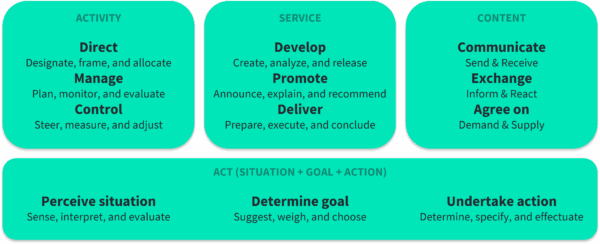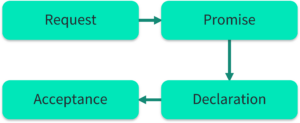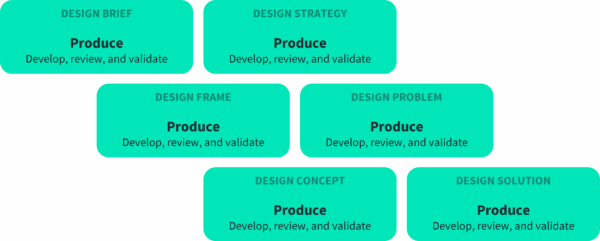As a design leader, are you looking to increase the power of design in your organization? This handbook explains how to apply IAC, the in-house method of Design Impulse to strengthen the capabilities of your design team. We regularly update the content to ensure IAC’s usability.
E-mail us if you have any questions, remarks, or suggestions regarding our handbook.

Handbook: Requirements
Competencies you need to be able to apply IAC:
- Market analysis
- Organization analysis
- Organization design
- Strategic thinking
- Business analysis
- Business design
- Process analysis
- Process design
- Capability mining
Estimated effort you need to put into applying IAC (including reporting of results):
Handbook: Steps
Preparation
The steps in the preparation phase focus on your ambition to increase the power of design:
Describe the current situation of your area of attention in your organization:
- Identify your area of attention.
- Process activity
- Business activity
- Organizational activity
- Describe the environmental factors of your area of attention.
- Macro-environmental factors (according to a PESTEL analysis; see, for instance, OnStrategy for an explanation with examples)
- Political factors
- Economic factors
- Social factors
- Technological factors
- Environmental factors
- Legal factors
- Meso-environmental factors (according to a five-forces analysis; see, for instance, B2U for an explanation with examples)
- Threat of new entrants
- Threat of substitutes
- Bargaining power of customers
- Bargaining power of suppliers
- Competitive rivalry
- Micro-environmental factors (according to a SWOT analysis; see, for instance, IMD for an explanation with examples)
- Strengths (i.e., characteristics that entail an advantage)
- Weaknesses (i.e., characteristics that entail a disadvantage)
- Opportunities (i.e., elements in the environment that could entail an advantage)
- Threats (i.e., elements in the environment that could entail a disadvantage)
- Macro-environmental factors (according to a PESTEL analysis; see, for instance, OnStrategy for an explanation with examples)
- Describe challenges for your area of attention that you want to tackle.
- Gaps (i.e., things your area of attention should start doing)
- Defects (i.e., things your area of attention should do better)
- Levers (i.e., things your area of attention should do more)
State your ambition to increase the power of design:
- Specify what power of design you want to increase to tackle the described challenges.
- Change
- Creation
- Improvement
- Variation
- Creativity
- Innovation
- Adaptation
- Transformation
- Return
- Impact
- Leads
- Orders
- Follow-ups
- Value
- Social value
- Environmental value
- Economic value
- Performance
- Scope
- Quality
- Benefit
- Time efficiency
- Cost efficiency
- Risk management
- Impact
- Change
- Define indicators that measure the fulfilment of your ambition. For example:
- Number of new product categories in the assortment.
- Costs of developing products, in an absolute sense or as a percentage of total project costs.
- Revenue from the sales of products, in an absolute sense or as a percentage of total revenue.
- Determine a target value range and the current value for each indicator.
- Minimum
- Optimum
- Maximum
Estimate whether your ambition can be fulfilled:
- Assess any earlier initiatives.
- Check the availability of required resources for the new initiative.
- Personnel
- Documentation
- Data points
- Analyze whether fulfilling your ambition is worthwhile.
- Desirable
- Feasible
- Viable
Execution
The steps in the execution phase of IAC focus on strengthening the capabilities of your design team for your area of attention:
Inventory capabilities for your area of attention that your design team deploys, taking into account different participants (such as the commissioner, designers, customers, users, subject matter experts, contractors, and managers) and using study models as a point of reference.

- Act purposefully (according to a study model of purposeful action developed by Norman (2002)):
- Perceive a situation
- Sense (e.g., see, hear, touch, smell, and taste)
- Interpret (i.e., understand)
- Evaluate (i.e., compare with a goal)
- Determine a goal
- Suggest
- Weigh (against other goals)
- Choose
- Undertake an action
- Determine
- Specify (i.e., visualize and prescribe)
- Effectuate
- Perceive a situation
- Share content
- Communicate
- Send
- Receive
- Exchange
- Inform
- React
- Agree on (based on the DEMO methodology, see figure below)
- Demand
- Request
- Promise
- Supply
- Declare
- Accept
- Demand
- Communicate

- Provide a service (based on the service quality gap model)
- Develop
- Create
- Analyze
- Release
- Promote (loosely based on the AIDA model for marketing)
- Announce
- Explain
- Recommend
- Deliver
- Prepare
- Execute*
- Conclude
- Develop
- Administer an activity
- Direct
- Designate
- Frame
- Allocate
- Manage
- Plan
- Monitor
- Evaluate
- Control
- Steer
- Measure
- Adjust
- Direct

*) Produce a design (consisting of a design brief, a design strategy, a design frame, a design problem, a design concept, and a design solution)
- Develop
- Create
- Analyze
- Release
- Review
- Validate
Discover valuable capabilities for your area of attention that your design team does not deploy. To this end, you research the design market.
- Market characteristics
- Customers
- Competitors
- Marketplaces
- Environmental factors
- Macro-environmental factors
- Meso-environmental factors
- Micro-environmental factors
- Challenges
- Gaps
- Defects
- Levers
Determine the influence of identified capabilities for your area of attention on ambition fulfilment indicators.
- Positive influence
- (Net) zero influence
- Negative influence
Classify the nature of an identified capability as:
- Knowledge if explicit (i.e., if it can be characterized by means of inference rules)
- Research if created yourself
- Education if adopted
- Experience if implicit (i.e., if it can be characterized by means of case parameters but not by means of inference rules)
- Experimentation if created yourself
- Witnessing if adopted
- Intuition if tacit (i.e., if it can be characterized by means of event reports but not by means of inference rules or case parameters)
- Instinct if created yourself
- Habituation if adopted
Rank an identified capability on the contribution to different organizational aspects of your area of attention.
- Reputation
- Organization strategy
- Stakeholder needs
- Technology
- Ethical conduct
- Regulatory
Determine the competitive advantage that an identified capability gives to your area of attention (on the basis of a VRIO analysis).
- If the capability is not valuable (i.e., unable to tackle opportunities and threats): disadvantage
- Otherwise, if the capability is not rare in your market (i.e., not scarce or difficult to obtain): equal advantage
- Otherwise, if the capability is not inimitable in your market (i.e., not hard to mimic): temporary advantage
- Otherwise, if the capability is not organized in your design team (i.e., unable to take full advantage of resources): unused advantage
- Otherwise: strategic advantage
Acquire discovered capabilities.
- Acquire in the form of knowledge
- Theorize in the case of research
- Study and learn in the case of education
- Acquire in the form of experience
- Try in the case of experimentation
- Observe and learn in the case of witnessing
- Acquire in the form of intuition
- Recruit in the case of instinct
- Accept and learn in the case of habituation
Renew identified capabilities that are not valuable, rare, or inimitable (using SCAMPER).
- Substitute
- Combine
- Adjust
- Modify
- Put to another use
- Eliminate
- Reverse
Anchor identified capabilities that are valuable but not organized in your design team according to its organization design (in line with the McKinsey 7S framework).
- Strategy
- Structure
- System
- Specialisms
- Skills
- Shared values
Consult Shadbolt & Smart (2015) for methods, techniques, and tools to capture a capability (in the form of, for instance, inference rules, case parameters, and event reports).
Conclusion
The steps in the completion phase of IAC focus on evaluating the fulfilment of your ambition:
Inventory the outcomes of fulfilling your ambition.
- Successes (i.e., objectives achieved exactly to the extent intended)
- Windfalls (i.e., objectives achieved to a larger extent than intended)
- Setbacks (i.e., objectives not achieved to the extent intended)
Determine the causes that explain the outcomes of fulfilling your ambition.
- Determine hypotheses
- Test hypotheses
- Confirm hypotheses
Propose the next move to fulfil your ambition.
- Renew if your ambition has been achieved
- Repeat if your ambition has not been achieved but still can be achieved
- Reformulate if your ambition cannot be achieved and needs to be adjusted
Handbook: Example solutions
In this handbook, you will find a few example solutions below. They originate from scientific and professional literature and practical experience. From time to time, we will update this non-exhaustive overview.
Increase change
Let people explore the future, get familiar with it, and work together to address the resistant factors. — Livework
Cultivate trust, give your people consistent support, and change up common routines every so often to create positive surprises. — User Experience
Increase creativity
Bring ideas to fruition through a build-measure-learn feedback loop (Lean Startup). — Eric Ries
Empathize, define, ideate, prototype, and test. — Stanford d.school
To produce an innovative outcome for a complex challenge, iteratively explore, define, develop, and deliver. — Design Council
Increase return
Define quantified metrics, build a holistic metrics system, and define supporting operational metrics. — McKinsey Design
Turbocharge processes, speed up internal feedback loops, and improve handoffs. — Invision Inside Design
Set goals, determine ground rules, and provide facilities to acquire, create, and share knowledge. — UNStudio
Represent design at the top level of the organization, improve employee experience with design, and spread design practices. — McKinsey Design
Build up your reputation, spot talent through your network, and establish a flexible talent pipeline. — Workable
Describe design work in terms of business goals, collect evidence of design results, and communicate the business value of design. — BoagWorld
Form a cross-disciplinary team, further knowledge integration, and implement decision-making through consensus. — Purdue University
Demonstrate desired behaviours, provide motivators, and recognize and acknowledge displayed behaviours. — PositivePsychology
Combine scale with agility. — David Butler & Linda Tischler
Translate the corporate vision into tangible goals, center the customer, foster collaboration, and uphold operational excellence—all while expanding creative limits. — Aquent
Define a portfolio strategy, identify gaps and unmet or latent needs, and define segments for customers and users. — McKinsey Design
Explore user experiences, discover user motives, and define user requirements. — Interaction Design Foundation
Recognize and remove overly complex content, organize knowledge, and filter content. — UX Collective
Background information
IAC is based on McKinsey’s capabilities strategy for successful product development (2017). See definitions for an explanation of terms used in this handbook. Below are links to publications of supporting expertise and background knowledge.

